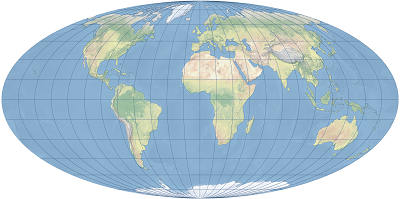Description
The Mollweide projection is an equal-area pseudocylindrical map projection displaying the world in a form of an ellipse with axes in a 2:1 ratio. It is also known as Babinet, elliptical, homolographic, or homalographic projection. The projection is appropriate for thematic and other world maps requiring accurate areas.
Mollweide was first introduced by Karl B. Mollweide in 1805. It is available in ArcGIS Pro 1.0 and later and in ArcGIS Desktop 8.0 and later.
Esri

Projection properties
The subsections below describe the Mollweide projection properties.
Graticule
Mollweide is a pseudocylindric projection. The equator and the central meridian are projected as two perpendicular straight lines. The central meridian is half the length of the projected equator. Two meridians, 90° east and 90° west of the central meridian, project as a circle. The other meridians are regularly distributed semi-ellipses concave toward the central meridian. All parallels are unequally distributed straight lines perpendicular to the central meridian. Their spacing decreases away from equator. The projection outline forms a shape of an ellipse. The poles are presented as points and they are covertices of the ellipse (on the minor axis). The graticule is symmetric across the equator and the central meridian.
Distortion
Mollweide is an equal-area (equivalent) projection. Shapes, directions, angles, and distances are generally distorted. Points 40°44' north and south at the central meridian have zero distortion. The scale is correct along the 40°44' north and south parallels and constant along any given parallel. Bulging outer meridians produce considerable distortion toward the edge of the projection, especially at high latitudes. Distortion values are symmetric across the equator and the central meridian.
Usage
The Mollweide projection is appropriate for small-scale mapping, especially for thematic world maps illustrating area characteristics and analysis requiring accurate areas.
Variants
There are two variants available in ArcGIS. Both implementations correctly support sphere-based Earth models.
- Mollweide is available in ArcGIS Pro 1.0 and later and in ArcGIS Desktop 8.0 and later. For ellipsoids this variant uses the semimajor axis and spherical equations.
- Mollweide auxiliary sphere is available in ArcGIS Pro 1.0 and later and in ArcGIS Desktop 9.3 and later. For ellipsoids this variant uses a sphere specified by the Auxiliary Sphere Type parameter and spherical equations.
Limitations
For an ellipsoid of revolution, the equal-area property is only maintained with the Mollweide auxiliary sphere variant when the Auxiliary Sphere Type 3 is used. Otherwise, areas are not maintained for the ellipsoids.
Parameters
Mollweide parameters are as follows:
- False Easting
- False Northing
- Central Meridian
Mollweide auxiliary sphere parameters are as follows:
- False Easting
- False Northing
- Central Meridian
- Auxiliary Sphere Type, with values as follows:
- 0 = Use semimajor axis or radius of the geographic coordinate system
- 1 = Use semiminor axis or radius
- 2 = Calculate and use authalic radius
- 3 = Use authalic radius and convert geodetic latitudes to authalic latitudes
Sources
Snyder, J. P. (1987). Map Projections: A Working Manual. U.S. Geological Survey Professional Paper 1395. Washington, DC: United States Government Printing Office.
Snyder, J. P. (1993). Flattening the Earth. Two Thousand Years of Map Projections. Chicago and London: University of Chicago Press.
Snyder, J. P. and Voxland, P. M. (1989). An Album of Map Projections. U.S. Geological Survey Professional Paper 1453. Washington, DC: United States Government Printing Office.